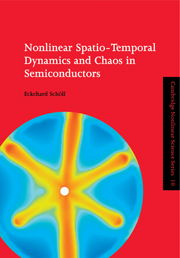Book contents
- Frontmatter
- Contents
- Preface
- Chapter 1 Semiconductors as continuous nonlinear dynamic systems
- Chapter 2 Concepts of nonlinear charge transport in semiconductors
- Chapter 3 Pattern formation and oscillatory instabilities in semiconductors
- Chapter 4 Impact-ionization-induced impurity breakdown
- Chapter 5 Nonlinear carrier dynamics in crossed electric and magnetic fields
- Chapter 6 Stationary and oscillating domains in superlattices
- Chapter 7 Spatio-temporal chaos
- References
- Index
Chapter 4 - Impact-ionization-induced impurity breakdown
Published online by Cambridge University Press: 17 September 2009
- Frontmatter
- Contents
- Preface
- Chapter 1 Semiconductors as continuous nonlinear dynamic systems
- Chapter 2 Concepts of nonlinear charge transport in semiconductors
- Chapter 3 Pattern formation and oscillatory instabilities in semiconductors
- Chapter 4 Impact-ionization-induced impurity breakdown
- Chapter 5 Nonlinear carrier dynamics in crossed electric and magnetic fields
- Chapter 6 Stationary and oscillating domains in superlattices
- Chapter 7 Spatio-temporal chaos
- References
- Index
Summary
In this chapter we discuss a model system that has been studied thoroughly both experimentally and theoretically within the last decade: Impurity impact-ionization breakdown at low temperatures. This system exhibits a variety of temporal and spatiotemporal instabilities ranging from first- and second-order nonequilibrium phase transitions between insulating and highly conducting states via current filamentation and traveling waves to various chaotic scenarios. There are several models that can account for periodic and chaotic current self-oscillations and spatio-temporal instabilities. Here we focus on a model for low-temperature impurity breakdown that combines Monte Carlo simulations of the microscopic scattering and generation–recombination processes with macroscopic nonlinear spatio-temporal dynamics in the framework of continuity equations for the carrier densities coupled with Poisson's equation for the electric field. A period-doubling route to chaos, traveling-wave instabilities, and the dynamics of nascent and fully developed current filaments are discussed including two-dimensional simulations for thin-film samples with various contact geometries.
Introduction
Impact ionization of charge carriers is a widespread phenomenon in semiconductors under strong carrier heating. It is a process in which a charge carrier with high kinetic energy collides with a second charge carrier, transferring its kinetic energy to the latter, which is thereby lifted to a higher energy level. Impact-ionization processes may be classified as band–band processes or band–trap processes depending on whether the second carrier is initially in the valence band and makes a transition from the valence band to the conduction band, or initially at a localized level (trap, donor, or acceptor) and makes a transition to a band state (Landsberg 1991).
- Type
- Chapter
- Information
- Nonlinear Spatio-Temporal Dynamics and Chaos in Semiconductors , pp. 152 - 219Publisher: Cambridge University PressPrint publication year: 2001



